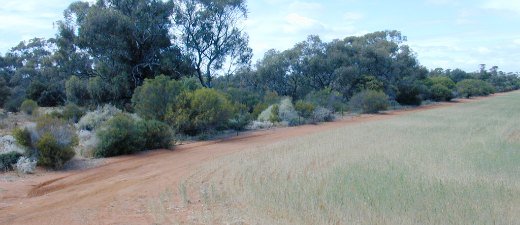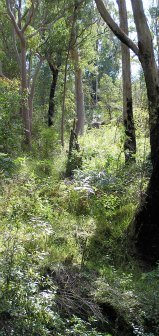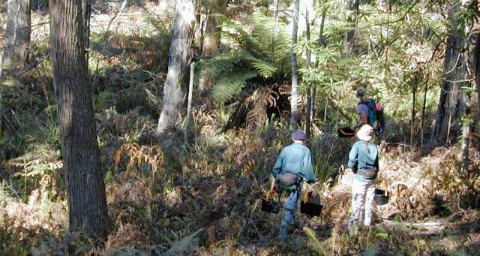Home | About CCW | Contact Us | Climate change Meaning | Causes | Solutions | Emissions | Carbon trading
Biosequestration | a fancy name for the end product of photosynthesis
Biosequestration is the capture of carbon from the atmosphere by the biological process of photosynthesis — and without it we would not be here.
The fixing of carbon from the atmosphere into carbohydrates is what provides our food and forms the basis of food chains for just about every organism on Earth.
Plants have been doing this for over 2,000 million years — an incomprehensibly long period of time. It is so fundamental a process of nature that we take it as a given, and for granted.
The fancy name 'biosequestration' was coined for one of the solutions to help balance greenhouse gas and carbon emissions as part of climate change policy.
A glance at this image below taken near the north of the wheat belt in Western Australia is enough to see the opportunity...

In the foreground to the right is a cleared field that has a crop on it for part of the year.
Once the crop, wheat in this case, is harvested, the grain is processed, made into bread and eaten with jam. The rest of the plant is eaten by livestock, ploughed back into the soil or even burnt.
Most of the carbon taken up [sequestered] by the wheat plants is taken away from the field or is returned to the atmosphere through decomposition.
On the left of the image is natural woodland. This vegetation is the same as that cleared to create the wheat field.
Given that woody vegetation is roughly 50% carbon, just by eye we would expect that the woodland holds more carbon than the wheat field. And measurements confirm that it does.
The trees also sequester carbon continually as they grow. There will be interruptions through fire, disease or when individual trees die and decompose but most woodlands and forests are net carbon sinks.
Conversion of wooded land to arable fields (from the left to the right of the image) has created food source for humans and a business opportunity for the farmer and his supply chain — it has also released greenhouse gases to the atmosphere both from the lost vegetation and from the exposed soil.
Why do we need biosequestration?

Since the industrial revolution around 136,000 million tCO2e of greenhouse gas emissions have come from land clearing for agriculture and livestock production.
This is a little under half the 270,000 million tCO2e from the combustion of fossil fuels.
Even today emissions from land clearing are around 13% of the annual global total from human activities.
Biosequestration is the carbon opportunity created from the rehabilitation of cleared and degraded land — regrowth of mostly woody vegetation on land that would otherwise be left fallow or with a cover of weeds.
As the trees grow they will sequester carbon and leave less carbon in the atmosphere than if the land had remained cleared.
If vegetation had to be cleared then any biosequestration is the difference in the carbon in the newly grown trees minus the carbon in the cleared vegetation. Often this is a net gain in carbon to the atmosphere.
Making sure that regorwth is actually a net reduction to greenhouse gases in the atmosphere requires some complex carbon trading rules to measure the amounts of carbon in the trees that contribute to emission reduction.
Not just in the trees
It is easy to see the trees and think that there must be more carbon in them than in the wheat field. And there is.
But nearly half the carbon in most habitats is actually below-ground in the soil as roots, organic material and soil organisms. This carbon in soil is not as easy to measure and is a complication for the carbon accounting rules.
Just like regrowth of forest so degraded soil carbon pools can also be built up again.
In many degraded soils sequestration of up to 1 tCO2e per hectare per year can be achieved with the right land management.
The conundrum
If emission reduction is a serious target for emission reduction policy, then sequestration into vegetation and soil on degraded and cleared land will be important action in achieving it.
Growing trees and securing carbon into soil is not a panacea. There is not enough land for the size of the task. Plus land is needed for agriculture to feed a growing and more calorie hungry population.
But there is a bonus to thinking about biosequestration as a solution. Land with more carbon in it tends to be more productive than similar land with less carbon. More carbon usually means more biological activity and this has many beneficial effects on production.
So the fancy word for photosynthesis is an opportunity for a global warming solution, only it has yet to be taken seriously.
climate change wisdom › solutions › biosequestration
Recent Articles
-
Reducing emissions while looking for solutions...
Nov 01, 15 04:46 PM
I've seen a lot of post's online for ideas on reducing emissions. The one suggestion I have not seen, is the most obvious. There should be a government -
Climate change evidence
Mar 24, 15 06:22 AM
Real climate change evidence has to demonstrate a change in climate. An extra sunny day or a severe storm or a flood is not enough. -
The climate change effect
Feb 19, 15 03:08 AM
What will be the climate change effect? There isn't one, there are many. Perhaps too many for us to understand.


New! Comments
Have your say about what you just read! Leave me a comment in the box below.